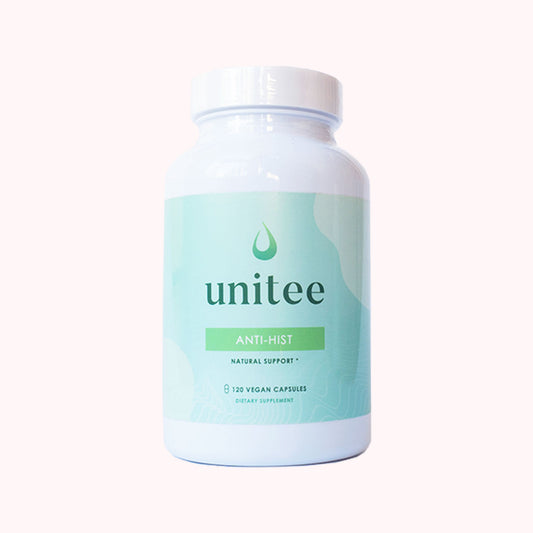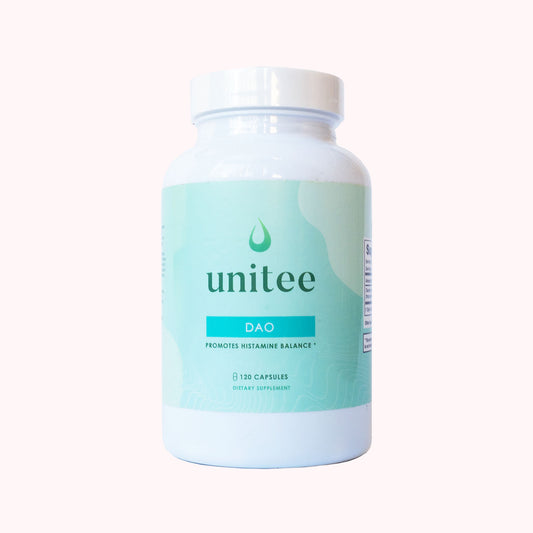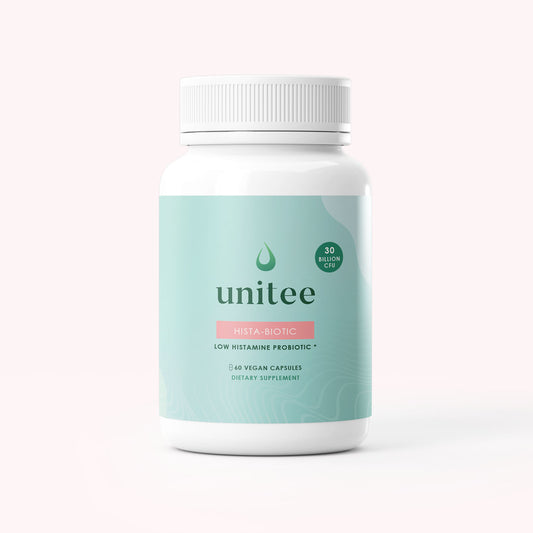Did your histamine intolerance start in your genes?
Constant headaches that often turn into migraines. Anxiety, irritability and mood disturbances. Nausea, digestive symptoms and reactions to even healthy foods. Constant runny nose, sneezing, itching eyes or skin…
These are typically the result of symptoms caused by allergies.
In some of you, however, they may not be related to common factors you’d expect to be allergic to that are present in the environment, like pollen and dust, for example. Instead, they are due to an allergy-mimicking response that is being stimulated within your body.
An allergy-mimicking reaction, called a pseudoallergic reaction, involves processes taking place in the body, stimulating immune cells like the histamine-containing mast cells and basophils to destabilize. While this normally happens as a result of a foreign invader threatening destruction of the body's tissues, a pseudoallergic response can happen as a result of a non-threatening compound stimulating the immune system (1). The mast cells and basophils then release their histamines, causing you to have higher than normal histamine levels in the body.
In addition to histamines increasing from stimulation of the mast cells and basophils, many people with histamine intolerance also have to contend with other various sources of histamines contributing to higher than tolerated histamine levels in the body. Histamine levels can increase from exposure to and ingestion of external histamine-containing foods, but they are also internally produced by bacteria. Internal sources may also increase as a result of a reduced capacity to break histamines down, often relating to a genetic predisposition, which we'll get to in a minute (2,3,4).
In any event, whether the levels of histamine in the body are from external or internal sources, the problems start when the levels become chronically high. It's then that abnormal symptoms develop and continue unabated.
But histamine is not all bad. We actually need it. It is an important molecule in the body (5) that is involved in reactions to true allergic responses, the pathways involving immunity and your body’s defense system (6), in blood pressure control and even in mental health and chemical messenger systems (7) that are part of the intricate workings of every process in the body.
Without histamine, these features would surely not work as they should (8)... but the trouble is, they don’t work as well either, when histamine levels are too high.
While you already know that histamine comes from various sources, we want to focus on perhaps one of the lesser known causes: your genes. And more specifically, what is it about your genes that leaves you vulnerable to histamine intolerance and all of those dreadful, and sometimes debilitating, symptoms you have to live with?
Genetic Mutations and Their Role in Histamine Intolerance
Your DNA dictates how, when, and why your body performs each and every function that it does.
And while you can't change your DNA or your genes, the environment that you are exposed to has the ability to change what those genes do. In that way, you can control how your genes respond to certain stimuli.
Now, the science of how your DNA and genes work is important to understand when it comes to how they influence your likelihood of developing a histamine intolerance or not. But, without getting too technical, if you remember from your high school biology class, your DNA is made up of two strands that interlink with one another (click the link for an image of a simplified version of a DNA strand for a better understanding). Each of the strands are made up of a number of single chemical compounds, arranged like a list on a strand. When the one strand lines up with the other strand, each of the chemical compounds meets its complementary match.
The chemical compounds are called bases and are designated by the letters A, C, G and T. A always pairs with T and C always pairs with T, essentially leaving AT and CG (or TA, GC, ) base pairs ready to be used to make a protein. It takes a combination of at least three of these base pairs to make one amino acid and sometimes hundreds or thousands of amino acids to make a single protein. It's this protein that then goes on to perform a very specific function.
What does that have to do with histamine intolerance, you ask?
Well, in the histamine pathway, the enzyme that degrades histamine is called diamine oxidase or DAO. It too is made as a result of specific proteins that are made up of the amino acids stemming from the base pairs linking on the DNA. The gene that tells the body how much DAO to produce is called the AOC1 gene (9), and it is normally coded by CC base pairs.
I know, we're getting a bit technical here...but, don’t worry, you don’t have to remember all of these letters, there’s no test at the end of this article, I promise!
It is, however, important to have even a little bit of an understanding of how your genes work, as it may help you to see where the imbalances in your body might be stemming from.
Ok, so, let's dive deeper...
When Your Genes Have Mutations, Diamine Oxidase Levels Just Don’t Cut It
Genes are built in their sequences when you begin growing in the womb and each code is carefully put together.
But, just as how it’s easy to make a typo when you write an email for example. Of course, you know what you want to type, but your fingers get tied up and you press the wrong button! Your body doesn’t have time to press the backspace, and so the wrong base pair letter might slip in every now and then.
In the histamine pathway, the normal CC pair might erroneously become a CT pair. This change from a C to a T is called a single nucleotide polymorphism or SNP, which is pronounced ‘snip’.
Because of this SNP, there is a slight change in the activation of the AOC1 gene (that gene that tells the body how much DAO to produce).
As a result, a C to T SNP makes a slightly different protein, but this protein is no longer specific for making DAO. And so, a C to T SNP reduces the capacity of the body to make sufficient levels of DAO (10).
There’s another common SNP in this process. Instead of a CC pair, the typo involves not just one base pair, but two, leaving a T base paired to another T base. Now there's not a C in sign in this combination, and the protein made is even more off the mark that the CT combination. With such a difference in the pairs, a TT combination has even less capacity to stimulate DAO production than the single SNP CT pair (10).
With either of the SNPs, the end result is that you simply don’t have enough DAO to break down even normal levels of histamine in the body, which results in a condition called primary DAO insufficiency (11).
It leaves your body's histamine levels slowly increasing over time, causing the subsequent histamine-related symptoms to become chronic. The levels of histamine in the body are simply allowed to reach a point that the body can no longer tolerate; and without the right gene pairs laid out in your DNA, there simply isn't ever going to be enough DAO to help!
...from internal sources, that is.
One of the primary therapies available for DAO insufficiency is to use a DAO enzyme supplement. It can assist in breaking down histamine that is entering the body from sources like you ingest from food or are exposed to through the environment. Using a DAO supplement tends to help so many people, as it increases tolerance to histamine and reduces histamine associated symptoms.
DAO is not the only enzyme the body uses to degrade histamine. And it's not the only enzyme prone to genetic mutations and histamine intolerance...
Another Sinister Genetic Mutation Leaving You Prone to Histamine Intolerance
HNMT is often not referred to as heavily as DAO because it is more specific to histamine levels in the central nervous system (12), i.e. the brain and spinal cord, whereas DAO activity is widespread throughout the body (13).
Like DAO mutations, HNMT SNPs are also fairly common (14,15), as are mutations in other genes coding for histamine receptor responses (16). Changes in receptor genes can also change the way histamine binds to the receptor, which also changes the way the receptor elicits the response.
If you do have an issue with histamine intolerance, and are really struggling with resolving your symptoms or uncovering the root cause, a genetic test for these SNPs could be very helpful in determining the treatment you, as an individual, may require.
Should you not have access to these tests there are still ways you can reduce the effects that histamine has on your body.
Simple ways to reduce symptoms of histamine intolerance
One of the most impactful ways to reduce your symptoms in a short period of time is to change your diet.
By reducing the histamine load in your gut, you can allow your body to better process the histamine levels it is already trying to deal with.
Following a low histamine diet, carefully selecting the foods you eat from this histamine intolerance foods list, can be very helpful in managing your symptoms (17,18,19).
It's important to remember that you don't just want to eliminate high histamine foods, but you also want to eliminate foods that trigger histamine release in the body or are bacterially converted to histamine, as well as implementing foods that are anti-inflammatory and stabilize histamine-releasing mast cells.
Sound confusing? Don't worry, with the FREE low-histamine food guide I have on offer for you, you'll be set and on your way to reducing your intake of histamine in no time!
Remember that you can also control your histamine levels by adding DAO enzymes back into your body through supplementation. You can also further stabilize your mast cells from releasing histamine by using a natural antihistamine and mast-cell stabilizers. It's a great way to support your immune system and reduce the release of histamine within your body that may be increasing as a result of that pseudoallergic response I mentioned earlier (20,21,22). The combination of a low histamine diet, DAO enzyme and mast cell stabilizer has helped countless of my clients to eat a wider variety of foods, drastically reducing their symptoms while targeting the root cause of their condition.
Healing the gut, reducing inflammation and managing stress are also important for overcoming histamine intolerance.
Fortunately, your health is not dictated by your genes; you have the ability to change what you eat and how you live so that those little ‘typos’ don’t dictate your ability to live healthy and well.
References
- Zhao Y, Zhang X, Jin H, Chen L, Ji J, Zhang Z. Histamine Intolerance-A Kind of Pseudoallergic Reaction. Biomolecules. 2022;12(3):454. Published 2022 Mar 15. doi:10.3390/biom12030454
- Nishino, S. et al. Decreased CSF histamine in narcolepsy with and without low CSF hypocretin-1 in comparison to healthy controls. Sleep 32, 175–180 (2009).
- Comas-Baste, O., et al. Histamine and Other Biogenic Amines in Food. From Scombroid Poisoning to Histamine Intolerance. Biogenic Amines. 2018.
- Gardini F, Özogul Y, Suzzi G, Tabanelli G, Özogul F. Technological factors affecting biogenic amine content in foods: A review. Frontiers in Microbiology. 2016;7:1218.
- Heidari, A., et al. Mutations in the histamine N-methyltransferase gene, HNMT, are associated with nonsyndromic autosomal recessive intellectual disability. Hum Mol Genet. 2015 Oct 15; 24(20): 5697–5710.
- Jutel M., et al. Immune regulation by histamine. Curr Opin Immunol. 2002 Dec; 14(6):735-40.
- Nahanuma, F., et al. Histamine N-methyltransferase regulates aggression and the sleep-wake cycle. Scientific Reportsvolume 7, Article number: 15899 (2017).
- Russo P, Spano G, Arena MP, Capozzi V, Fiocco D, Grieco F, et al. Are consumers aware of the risks related to biogenic amines in food? In: Mendez-Villas A, editor. Current Research, Technology and Education Topics in Applied Microbiology and Microbial Biotechnology. Badajoz: Formatex Research Center; 2010. pp. 1087-1095.
- Ayuso, P., et al. Genetic variability of human diamine oxidase: occurrence of three nonsynonymous polymorphisms and study of their effect on serum enzyme activity. Pharmacogenet Genomics. 2007 Sep;17(9):687-93.
- Jones, B., et al. Genetic Variation in the Histamine Production, Response, and Degradation Pathway Is Associated with Histamine Pharmacodynamic Response in Children with Asthma. Front. Pharmacol., 04 January 2017.
- Maintz, L., et al. Association of single nucleotide polymorphisms in the diamine oxidase gene with diamine oxidase serum activities. Allergy. 2011 Jul;66(7):893-902.
- Horton, J. R., Sawada, K., Nishibori, M., Zhang, X. & Cheng, X. Two polymorphic forms of human histamine methyltransferase: structural, thermal, and kinetic comparisons. Structure 9, 837–849 (2001).
- Bieganski, T. et al. Distribution and properties of human intestinal diamine oxidase and its relevance for the histamine catabolism. Biochim Biophys Acta756, 196–203 (1983).
- Pang, Y., et al. Theoretical 3D model of histamine N-methyltransferase: insights into the effects of a genetic polymorphism on enzymatic activity and thermal stability. Biochem Biophys Res Commun. 2001 Sep 14;287(1):204-8.
- Hon, Y., et al. Endogenous histamine and cortisol levels in subjects with different histamine N-methyltransferase C314T genotypes : a pilot study. Mol Diagn Ther. 2006;10(2):109-14.
- Sander, L., et al. Selective expression of histamine receptors H1R, H2R, and H4R, but not H3R, in the human intestinal tract. Gut. 2006 Apr; 55(4): 498–504.
- Son, J., et al. A Histamine-Free Diet Is Helpful for Treatment of Adult Patients with Chronic Spontaneous Urticaria. Ann Dermatol. 2018 Apr; 30(2): 164–172.
- Wantke F, Gotz M, Jarisch R. Histamine-free diet: treatment of choice for histamine-induced food intolerance and supporting treatment for chronic headaches. Clin Exp Allergy 1993;23:982–5.
- Wantke F, Gotz M, Jarisch R. The histamine-free diet. Hautarzt 1993;44:512–6 (in German).
- Yacoub, M., et al. Diamine Oxidase Supplementation in Chronic Spontaneous Urticaria: A Randomized, Double-Blind Placebo-Controlled Study. Int Arch Allergy Immunol 2018;176:268–271.
- Izquierdo-Casas, J., et al. Diamine oxidase (DAO) supplement reduces headache in episodic migraine patients with DAO deficiency: A randomized double-blind trial. Clinical Nutrition. 2019. 8(1):152-158.
- Schnedl, W., et al. Diamine oxidase supplementation improves symptoms in patients with histamine intolerance. Food Sci Biotechnol (2019).

Anita Tee
My name is Anita Tee. I'm a nutritional scientist who specializes in histamine intolerance. I hold a Master of Science in Personalized Nutrition and a Bachelor of Science in Human Biology and Psychology.
For the past ten years, I have used my experience in nutritional and medical health sciences to create a scientifically backed, natural approach to healthcare that relies 100% on evidence-based research.
As I previously suffered from - and overcame - histamine intolerance, my focus is to increase recognition and expand the available resources and protocols available for resolving this particular disorder. To date, I have helped over 4,000 individuals fully resolve or better manage their histamine intolerance symptoms.







